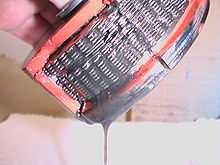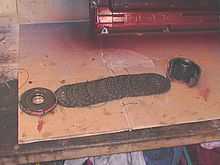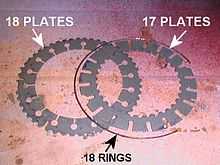Viscous coupling unit




A viscous coupling is a mechanical device which transfers torque and rotation by the medium of a viscous fluid. It is made of a number of circular plates with tabs or perforations, fitted very close to each other in a sealed drum. Alternate plates are connected to a driving shaft at one end of the assembly and a driven shaft at the other end. The drum is filled with a dilatant fluid, often silicone-based. When the two sets of plates are rotating in unison, the fluid stays cool and remains liquid. When the plates start rotating at different speeds, the shear effect of the tabs or perforations on the fluid will cause it to heat and become nearly solid because the viscosity of dilatant fluids rapidly increases with shear. The fluid in this state will effectively glue the plates together and transmit power from one set of plates to the other. The size of the tabs or perforations, the number of plates, and the fluid used will determine the strength and onset of this mechanical transfer.
This type of device essentially differs from fluid couplings such as torque converters by using the viscosity of the medium to transfer torque, rather than its momentum. This makes it potentially useful even on very small scales. It tends to have less cooling. The torque transmitted is sensitive to the difference in speeds of the input and output but is almost independent of their common rate.
Viscous couplings are used as the center differential in some four-wheel-drive (4WD) vehicles such as the Toyota Celica GT-Four, and also as a limited slip differential (LSD) in rear axles. They offer a cheaper way to implement four-wheel-drive than technologies like the mechanical-transfer Torsen differentials used by Audis.
One of the first mass-produced viscous couplings for a permanent 4WD off-road-capable vehicle was used in the AMC Eagle, produced from 1980 to 1987. The AMC Eagle's central differential was single-speed (no low range option) and used a thick viscous fluid coupling for quiet and smooth transfer of power to the axle with the greatest traction, on wet or dry pavement
Volvo, Subaru, Range Rover, Vauxhall/Opel and many others have used viscous couplings in their drivelines at various times, now mostly superseded by more complicated electronically controlled devices.
Attributions
Tony Rolt is often credited with the original idea and development as applied to automatic couplings in vehicle transmission systems, particularly four-wheel drive, working with Freddie Dixon at the time. Ferguson Research Ltd. and FF Developments were the companies formed (1970's) to commercialise much early work into 4WD systems and devices. It is thought that GKN Driveline own any remaining worldwide patents today[citation needed] and offer several variants and combinations of Viscous Couplings integrated with other driveline components.[citation needed]
See also
- Hele-Shaw clutch
- Limited slip differential
External links
- Interactive animation
- http://syncro.org/VCTest.html
- http://www.autozine.org/technical_school/traction/tech_traction_4wd_2.htm
- Some torque~temp VC calibration curves